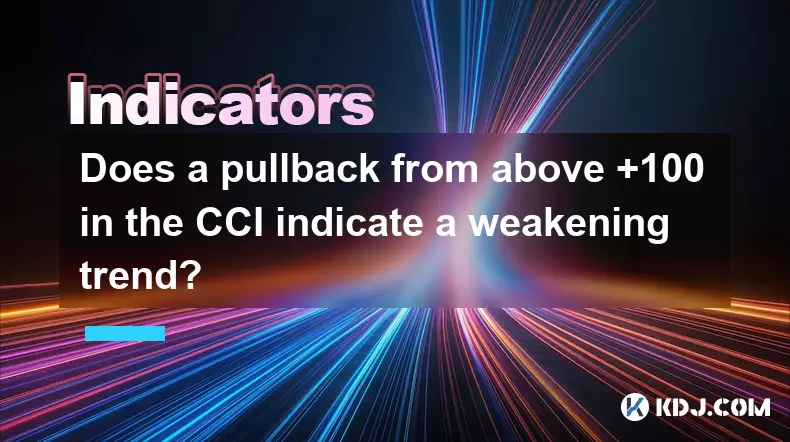-
 bitcoin
bitcoin $116750.837634 USD
1.11% -
 ethereum
ethereum $4515.341020 USD
-0.47% -
 xrp
xrp $3.043113 USD
1.49% -
 tether
tether $1.000476 USD
0.02% -
 bnb
bnb $959.123861 USD
4.03% -
 solana
solana $236.571244 USD
0.47% -
 usd-coin
usd-coin $1.000002 USD
0.00% -
 dogecoin
dogecoin $0.269342 USD
-0.14% -
 tron
tron $0.343000 USD
-0.81% -
 cardano
cardano $0.880538 USD
1.74% -
 hyperliquid
hyperliquid $54.247044 USD
1.00% -
 chainlink
chainlink $23.521588 USD
-0.41% -
 ethena-usde
ethena-usde $1.001241 USD
0.01% -
 sui
sui $3.597422 USD
1.64% -
 avalanche
avalanche $30.081531 USD
1.20%
How can I identify a rebound selling point after a moving average system shows a bearish pattern?
A bearish moving average crossover, like the "death cross," signals potential downtrend continuation, especially when confirmed by volume and momentum indicators.
Sep 11, 2025 at 09:18 am

Understanding Bearish Patterns in Moving Average Systems
1. A bearish pattern in a moving average system typically occurs when a short-term moving average crosses below a long-term moving average. This crossover is commonly referred to as a 'death cross' in technical analysis circles. Traders interpret this as a strong signal of downward momentum building in the market. The crossover suggests that recent price action is weakening compared to historical averages, which often precedes further declines.
2. Volume confirmation plays a critical role in validating the bearish signal. A drop in price accompanied by rising volume strengthens the reliability of the bearish pattern. Conversely, if the crossover happens with low volume, it may indicate a lack of conviction among sellers, potentially leading to a false signal. Monitoring on-chain volume data in cryptocurrency markets can offer deeper insights into whether institutional or retail traders are driving the move.
3. Additional indicators such as the Relative Strength Index (RSI) and MACD can help confirm overbought or oversold conditions following the bearish crossover. If RSI dips below 30 shortly after the moving average cross, it may suggest the asset is oversold, increasing the probability of a short-term rebound. However, this does not negate the overall bearish trend—it only highlights a potential temporary bounce.
Spotting Rebound Selling Opportunities
1. After a bearish moving average crossover, price often retraces toward the now-resistance level formed by the long-term moving average, such as the 200-day MA. This retest offers a strategic selling point if price fails to reclaim the moving average. Traders watch for rejection patterns like bearish engulfing candles or shooting stars at this level.
2. Fibonacci retracement levels are useful tools for identifying potential rebound zones. Common retracement levels like 38.2%, 50%, and 61.8% from the prior uptrend can act as temporary resistance. If price approaches one of these levels while the moving averages remain in bearish alignment, it presents a high-probability area to initiate short positions or take profits on longs.
3. Divergence between price and momentum indicators can signal a weakening rebound. For example, if price makes a higher high during the bounce but the MACD forms a lower high, it indicates diminishing bullish momentum. This bearish divergence is a strong clue that the rebound is losing steam and a reversal to the downside may be imminent.
Managing Risk in Rebound Trade Setups
1. Position sizing should be adjusted according to the strength of the bearish signal and the volatility of the asset. In highly volatile crypto markets, smaller position sizes help mitigate risk during uncertain rebounds. Using a percentage of portfolio allocation—such as no more than 2-3% per trade—can prevent overexposure.
2. Stop-loss placement is crucial. Placing a stop above the recent swing high of the rebound ensures that if the price breaks out strongly, the loss is contained. Some traders use a volatility-based stop, such as a multiple of the Average True Range (ATR), to account for sudden spikes in price movement common in digital assets.
3. Avoiding emotional trading during rebounds is essential. Many traders mistake a temporary bounce for a trend reversal, especially in highly speculative markets like cryptocurrencies. Sticking to predefined rules based on moving average structure and confirmation signals reduces impulsive decisions.
Common Questions About Rebound Selling in Crypto Markets
What is a death cross and why does it matter in crypto trading?A death cross occurs when the 50-day moving average falls below the 200-day moving average. It matters because it often signals a shift from a bullish to a bearish long-term trend. In volatile markets like Bitcoin or Ethereum, this pattern has historically preceded significant downturns, making it a key reference point for trend traders.
Can a rebound happen even after a confirmed bearish moving average crossover?Yes, rebounds are common after bearish crossovers. Markets rarely move in straight lines, and short-term bounces occur due to profit-taking, short covering, or temporary buying surges. These rebounds do not invalidate the bearish trend but offer tactical selling opportunities for experienced traders.
How do I confirm a failed rebound before entering a short position?Look for price rejection at key resistance levels, such as the 200-day MA or Fibonacci zones. Bearish candlestick patterns, declining volume on up-moves, and negative divergences in momentum indicators like RSI or MACD add confirmation. Entry is often timed when price breaks below the low of the rejection candle.
Are moving average crossovers more reliable in certain crypto assets?They tend to be more reliable in large-cap cryptocurrencies like Bitcoin and Ethereum due to higher liquidity and less susceptibility to manipulation. In low-cap altcoins, whipsaws and false signals are more frequent, so additional filters like volume and on-chain metrics are necessary to improve accuracy.
Disclaimer:info@kdj.com
The information provided is not trading advice. kdj.com does not assume any responsibility for any investments made based on the information provided in this article. Cryptocurrencies are highly volatile and it is highly recommended that you invest with caution after thorough research!
If you believe that the content used on this website infringes your copyright, please contact us immediately (info@kdj.com) and we will delete it promptly.
- Kraken & Circle: Leveling Up the Stablecoin Game with USDC & EURC
- 2025-09-18 02:25:17
- W Token 2.0: How Wormhole's Tokenomics Upgrade Shapes the Blockchain Future
- 2025-09-18 02:25:17
- Floki Crypto's Year-End Target: Bull Run on the Horizon?
- 2025-09-18 02:45:12
- Shiba Inu, Price Prediction, and DeepSnitch AI: What's the Buzz?
- 2025-09-18 03:05:14
- Avantis, BlockchainFX, and Presale Crypto: Finding the Next Big Thing
- 2025-09-18 02:30:12
- Dogecoin, Shiba Inu, and the Crypto Millionaires: A New Meme Coin Era?
- 2025-09-18 03:05:14
Related knowledge

How can I use the psychological line (PSY) to determine market sentiment?
Sep 17,2025 at 02:19pm
Understanding the Psychological Line (PSY) in Cryptocurrency TradingThe Psychological Line, commonly referred to as PSY, is a momentum oscillator used...

What does a death cross of the RSI in the strong zone (above 50) mean?
Sep 17,2025 at 10:54pm
Understanding the Death Cross in RSI Context1. The term 'death cross' is traditionally associated with moving averages, where a short-term average cro...

What is the Three Crows candlestick pattern? Is it a scary pattern?
Sep 18,2025 at 03:55am
Understanding the Three Crows Candlestick Pattern1. The Three Crows is a bearish reversal pattern in technical analysis, commonly observed after an up...

How can I use the bias to capture oversold rebounds?
Sep 17,2025 at 05:54pm
Understanding Bias in the Context of Crypto Market Movements1. The term 'bias' in cryptocurrency trading refers to a trader’s inclination toward a par...

What is the open-mouthed duck pattern on the MACD indicator?
Sep 17,2025 at 01:18pm
Understanding the Open-Mouthed Duck Pattern on MACDThe MACD (Moving Average Convergence Divergence) indicator is one of the most widely used tools in ...

Does a pullback from above +100 in the CCI indicate a weakening trend?
Sep 17,2025 at 11:37pm
Understanding the CCI Indicator in Crypto Trading1. The Commodity Channel Index (CCI) is a momentum-based oscillator widely used in cryptocurrency tra...

How can I use the psychological line (PSY) to determine market sentiment?
Sep 17,2025 at 02:19pm
Understanding the Psychological Line (PSY) in Cryptocurrency TradingThe Psychological Line, commonly referred to as PSY, is a momentum oscillator used...

What does a death cross of the RSI in the strong zone (above 50) mean?
Sep 17,2025 at 10:54pm
Understanding the Death Cross in RSI Context1. The term 'death cross' is traditionally associated with moving averages, where a short-term average cro...

What is the Three Crows candlestick pattern? Is it a scary pattern?
Sep 18,2025 at 03:55am
Understanding the Three Crows Candlestick Pattern1. The Three Crows is a bearish reversal pattern in technical analysis, commonly observed after an up...

How can I use the bias to capture oversold rebounds?
Sep 17,2025 at 05:54pm
Understanding Bias in the Context of Crypto Market Movements1. The term 'bias' in cryptocurrency trading refers to a trader’s inclination toward a par...

What is the open-mouthed duck pattern on the MACD indicator?
Sep 17,2025 at 01:18pm
Understanding the Open-Mouthed Duck Pattern on MACDThe MACD (Moving Average Convergence Divergence) indicator is one of the most widely used tools in ...

Does a pullback from above +100 in the CCI indicate a weakening trend?
Sep 17,2025 at 11:37pm
Understanding the CCI Indicator in Crypto Trading1. The Commodity Channel Index (CCI) is a momentum-based oscillator widely used in cryptocurrency tra...
See all articles

























![[Pycoin] PI Coin -History update progress !! Connection with legal money .. This is crazy / Pycoin mining speed acceleration [Pycoin] PI Coin -History update progress !! Connection with legal money .. This is crazy / Pycoin mining speed acceleration](/uploads/2025/09/17/cryptocurrencies-news/videos/pycoin-pi-coin-history-update-progress-connection-legal-money-crazy-pycoin-mining-speed-acceleration/68cab0e2a7747_image_500_375.webp)
















































